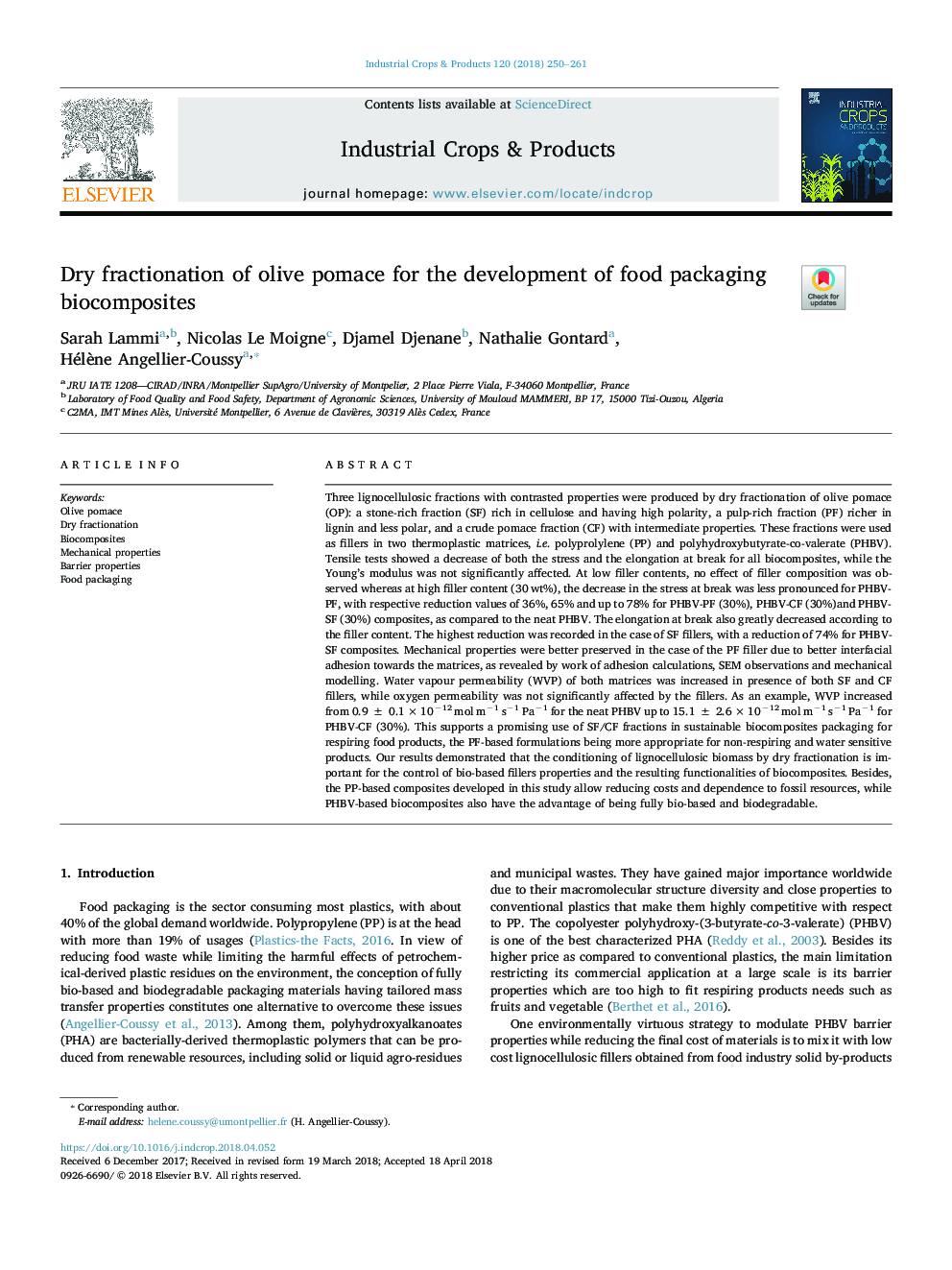| کد مقاله | کد نشریه | سال انتشار | مقاله انگلیسی | نسخه تمام متن |
|---|---|---|---|---|
| 8879933 | 1624790 | 2018 | 12 صفحه PDF | دانلود رایگان |
عنوان انگلیسی مقاله ISI
Dry fractionation of olive pomace for the development of food packaging biocomposites
ترجمه فارسی عنوان
کراکینگ کردن خشک زیتون برای توسعه بسته های زیستی بسته بندی مواد
دانلود مقاله + سفارش ترجمه
دانلود مقاله ISI انگلیسی
رایگان برای ایرانیان
کلمات کلیدی
موضوعات مرتبط
علوم زیستی و بیوفناوری
علوم کشاورزی و بیولوژیک
علوم زراعت و اصلاح نباتات
چکیده انگلیسی
Three lignocellulosic fractions with contrasted properties were produced by dry fractionation of olive pomace (OP): a stone-rich fraction (SF) rich in cellulose and having high polarity, a pulp-rich fraction (PF) richer in lignin and less polar, and a crude pomace fraction (CF) with intermediate properties. These fractions were used as fillers in two thermoplastic matrices, i.e. polyprolylene (PP) and polyhydroxybutyrate-co-valerate (PHBV). Tensile tests showed a decrease of both the stress and the elongation at break for all biocomposites, while the Young's modulus was not significantly affected. At low filler contents, no effect of filler composition was observed whereas at high filler content (30â¯wt%), the decrease in the stress at break was less pronounced for PHBV-PF, with respective reduction values of 36%, 65% and up to 78% for PHBV-PF (30%), PHBV-CF (30%)and PHBV-SF (30%) composites, as compared to the neat PHBV. The elongation at break also greatly decreased according to the filler content. The highest reduction was recorded in the case of SF fillers, with a reduction of 74% for PHBV-SF composites. Mechanical properties were better preserved in the case of the PF filler due to better interfacial adhesion towards the matrices, as revealed by work of adhesion calculations, SEM observations and mechanical modelling. Water vapour permeability (WVP) of both matrices was increased in presence of both SF and CF fillers, while oxygen permeability was not significantly affected by the fillers. As an example, WVP increased from 0.9â¯Â±â¯0.1â¯Ãâ¯10â12â¯molâ¯mâ1â¯sâ1â¯Paâ1 for the neat PHBV up to 15.1â¯Â±â¯2.6â¯Ãâ¯10â12â¯molâ¯mâ1â¯sâ1â¯Paâ1 for PHBV-CF (30%). This supports a promising use of SF/CF fractions in sustainable biocomposites packaging for respiring food products, the PF-based formulations being more appropriate for non-respiring and water sensitive products. Our results demonstrated that the conditioning of lignocellulosic biomass by dry fractionation is important for the control of bio-based fillers properties and the resulting functionalities of biocomposites. Besides, the PP-based composites developed in this study allow reducing costs and dependence to fossil resources, while PHBV-based biocomposites also have the advantage of being fully bio-based and biodegradable.
ناشر
Database: Elsevier - ScienceDirect (ساینس دایرکت)
Journal: Industrial Crops and Products - Volume 120, 15 September 2018, Pages 250-261
Journal: Industrial Crops and Products - Volume 120, 15 September 2018, Pages 250-261
نویسندگان
Sarah Lammi, Nicolas Le Moigne, Djamel Djenane, Nathalie Gontard, Hélène Angellier-Coussy,
